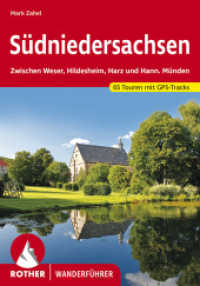- ホーム
- > 洋書
- > 英文書
- > Computer / Languages
Full Description
"I picked up a copy of JavaScript by Example over the weekend and wanted to thank you for putting out a book that makes JavaScript easy to understand. I've been a developer for several years now and JS has always been the "monster under the bed," so to speak. Your book has answered a lot of questions I've had about the inner workings of JS but was afraid to ask. Now all I need is a book that covers Ajax and Coldfusion. Thanks again for putting together an outstanding book."-Chris Gomez, Web services manager, Zunch Worldwide, Inc."I have been reading your UNIX (R) Shells by Example book, and I must say, it is brilliant. Most other books do not cover all the shells, and when you have to constantly work in an organization that uses tcsh, bash, and korn, it can become very difficult. However, your book has been indispensable to me in learning the various shells and the differences between them...so I thought I'd email you, just to let you know what a great job you have done!"-Farogh-Ahmed Usmani, B.Sc. (Honors), M.Sc., DIC, project consultant (Billing Solutions), Comverse"I have been learning Perl for about two months now; I have a little shell scripting experience but that is it. I first started with Learning Perl by O'Reilly. Good book but lacking on the examples. I then went to Programming Perl by Larry Wall, a great book for intermediate to advanced, didn't help me much beginning Perl. I then picked up Perl by Example, Third Edition-this book is a superb, well-written programming book. I have read many computer books and this definitely ranks in the top two, in my opinion. The examples are excellent. The author shows you the code, the output of each line, and then explains each line in every example."-Dan Patterson, software engineer, GuideWorks, LLC"Ellie Quigley has written an outstanding introduction to Perl, which I used to learn the language from scratch. All one has to do is work through her examples, putz around with them, and before long, you're relatively proficient at using the language. Even though I've graduated to using Programming Perl by Wall et al., I still find Quigley's book a most useful reference."-Casey Machula, support systems analyst, Northern Arizona University, College of Health and Human Services"When I look at my bookshelf, I see eleven books on Perl programming. Perl by Example, Third Edition, isn't on the shelf; it sits on my desk, where I use it almost daily. When I bought my copy I had not programmed in several years and my programming was mostly in COBOL so I was a rank beginner at Perl. I had at that time purchased several popular books on Perl but nothing that really put it together for me. I am still no pro, but my book has many dog-eared pages and each one is a lesson I have learned and will certainly remember. "I still think it is the best Perl book on the market for anyone from a beginner to a seasoned programmer using Perl almost daily."-Bill Maples, network design tools and automations analyst, Fidelity National Information Services"We are rewriting our intro to OS scripting course and selected your text for the course. It's an exceptional book. The last time we considered it was a few years ago (second edition). The debugging and system administrator chapters at the end nailed it for us."-Jim Leone, Ph.D., professor and chair, Information Technology, Rochester Institute of Technology"Quigley's book acknowledges a major usage of PHP. To write some kind of front end user interface program that hooks to a back end MySQL database. Both are free and open source, and the combination has proved popular. Especially where the front end involves making an HTML web page with embedded PHP commands. "Not every example involves both PHP and MySQL. Though all examples have PHP. Many demonstrate how to use PHP inside an HTML file. Like writing user-defined functions, or nesting functions. Or making or using function libraries. The functions are a key idea in PHP, that take you beyond the elementary syntax. Functions also let you gainfully use code by other PHP programmers. Important if you are part of a coding group that has to divide up the programming effort in some manner."-Dr. Wes Boudville, CTO, Metaswarm Inc.The World's Easiest Perl Tutorial-Fully Updated!Perl by Example, Fourth Edition, is the easiest, most hands-on way to learn Perl. Legendary Silicon Valley programming instructor Ellie Quigley has thoroughly updated her classic to deliver the skills and information today's Perl users need most-including all-new coverage of MySQL database programming and a Perl QuickStart designed to get experienced users up and running fast.Quigley illuminates every technique with focused, classroom-tested code examples, detailed line-by-line explanations, and real program output. This exceptionally clear, easy-to-understand book takes you from your first Perl script to database-driven applications. It's the only Perl book you'll ever need!New in this edition:Perl programming QuickStart: makes first-time Perl programmers productive in just twenty pages All-new chapter on using the Perl DBI with the MySQL database-plus an easy SQL primer to quickly get you started programming any databaseNew introductions to Perl in biology (bioinformatics) and to mod_perl, a Perl interpreter embedded in the Apache server, which allows you to create fast, dynamic content; manage the Apache server; authenticate users; and much moreCompletely updated:Includes many new and completely rewritten code examplesContains fully revised CGI coverage for building dynamic Web sites with PerlCovers modern Perl 5.8 concepts and principles-and provides a great foundation for Perl 6More than 30,000 sysadmins, power users, and developers have used previous editions of Perl by Exampleto become expert Perl programmers. With Perl by Example, Fourth Edition, you can, too-even if you'recompletely new to Perl. After you've become an expert, you'll turn to this book constantly as the bestsource for reliable answers, solutions, and code.About the CD-ROM:The CD-ROM includes all code and files for this book's hundreds of example scripts.
Contents
Preface xxviiChapter 111.1 What Is Perl? 11.2 What Is an Interpreted Language? 21.3 Who Uses Perl? 31.4 Where to Get Perl 51.5 What Is CPAN? 91.6 Perl Documentation 101.7 What You Should Know 121.8 What's Next? 12Chapter 2: Perl Quick Start 132.1 Quick Start, Quick Reference 132.2 Chapter Summary 292.3 What's Next? 29Chapter 3: Perl Scripts 313.1 Script Setup 313.2 The Script 323.3 Perl at the Command Line 393.4 What You Should Know 433.5 What's Next? 43Chapter 4: Getting a Handle on Printing 454.1 The Filehandle 454.2 Words 454.3 The print Function 464.4 The printf Function 594.5 What You Should Know 664.6 What's Next? 66Chapter 5: What's in a Name 695.1 About Perl Variables 695.2 Scalars, Arrays, and Hashes 775.3 Reading from STDIN 945.4 Array Functions 1005.5 Hash (Associative Array) Functions 1185.6 More Hashes 1285.7 What You Should Know 1325.8 What's Next? 133Chapter 6: Where's the Operator? 1376.1 About Perl Operators 1376.2 Mixing Data Types 1386.3 Precedence and Associativity 1396.4 What You Should Know 1686.5 What's Next? 168Chapter 7: If Only, Unconditionally, Forever 1717.1 Control Structures, Blocks, and Compound Statements 1717.2 Repetition with Loops 1777.3 What You Should Know 2007.4 What's Next? 200Chapter 8: Regular Expressions-Pattern Matching 2038.1 What Is a Regular Expression? 2038.2 Expression Modifiers and Simple Statements 2048.3 Regular Expression Operators 2108.4 What You Should Know 2328.5 What's Next? 232Chapter 9: Getting Control-Regular Expression Metacharacters 2359.1 Regular Expression Metacharacters 2359.2 Unicode 2819.3 What You Should Know 2839.4 What's Next? 283Chapter 10: Getting a Handle on Files 28510.1 The User-Defined Filehandle 28510.2 Passing Arguments 31010.3 File Testing 31910.4 What You Should Know 32110.5 What's Next? 322Chapter 11: How Do Subroutines Function? 32511.1 Subroutines/Functions 32511.2 Passing Arguments 33011.3 Call-by-Reference 34411.4 What You Should Know 35811.5 What's Next? 359Chapter 12: Modularize It, Package It, and Send It to the Library! 36312.1 Packages and Modules 36312.2 The Standard Perl Library 37012.3 Modules from CPAN 39012.4 What You Should Know 39812.5 What's Next? 398Chapter 13: Does This Job Require a Reference? 40113.1 What Is a Reference? What Is a Pointer? 40113.2 What You Should Know 42013.3 What's Next? 420Chapter 14: Bless Those Things! (Object-Oriented Perl) 42314.1 The OOP Paradigm 42314.2 Classes, Objects, and Methods 42514.3 Anonymous Subroutines, Closures, and Privacy 45314.4 Inheritance 46014.5 Public User Interface-Documenting Classes 47414.6 Using Objects from the Perl Library 47914.7 What You Should Know 48414.8 What's Next? 485Chapter 15: Those Magic Ties and DBM Stuff 49315.1 Tying Variables to a Class 49315.2 DBM Files 50515.3 What You Should Know 51215.4 What's Next? 512Chapter 16: CGI and Perl: The Hyper Dynamic Duo 51316.1 Static and Dynamic Web Pages 51316.2 How It all Works 51616.3 Creating a Web Page with HTML 52216.4 How HTML and CGI Work Together 52616.5 Getting Information Into and Out of the CGI Script 53116.6 CGI and Forms 53516.7 The CGI.pm Module 559Chapter 17: Perl Meets MySQL-A Perfect Connection 60317.1 Introduction 60317.2 What Is a Relational Database? 60417.3 Getting Started with MySQL 61317.4 What Is the Perl DBI? 63817.5 Statements that Don't Return Anything 66617.6 Transactions 67017.7 Using CGI and the DBI to Select and Display Entries 67217.8 What's Left? 67817.9 What You Should Know 67917.10What's Next? 679Chapter 18: Interfacing with the System 68518.1 System Calls 68518.2 Processes 72118.3 Other Ways to Interface with the Operating System 74718.4 Error Handling 75518.5 Signals 76018.6 What You Should Know 76418.7 What's Next? 765Chapter 19: Report Writing with Pictures 76719.1 The Template 76719.2 What You Should Know 78319.3 What's Next? 783Chapter 20: Send It Over the Net and Sock It to 'Em! 78520.1 Networking and Perl 78520.2 Client /Server Model 78520.3 Network Protocols (TCP/IP) 78520.4 Network Addressing 78720.5 Sockets 79420.6 Client /Server Programs 80020.7 The Socket.pm Module 80820.8 What You Should Know 813Appendix A: Perl Built-ins, Pragmas, Modules, and the Debugger 815A.1 Perl Functions 815A.2 Special Variables 845A.3 Perl Pragmas 848A.4 Perl Modules 850A.5 Command-Line Switches 856A.6 Debugger 858Appendix B: SQL Language Tutorial 863B.1 What Is SQL? 863B.2 SQL Data Manipulation Language (DML) 871B.3 SQL Data Definition Language 888B.4 SQL Functions 901B.5 Appendix Summary 910B.6 What You Should Know 910Appendix C: Perl and Biology 915C.1 What Is Bioinformatics? 915C.2 A Little Background on DNA 915C.3 Some Perl Examples 917C.4 What Is BioPerl? 919C.5 Resources 923Appendix D: Power and Speed: CGI and mod_perl 925D.1 What Is mod_perl? 925D.2 The mod_perl Web Site 927D.3 Installing mod_perl 928D.4 Resources 938Index 939







